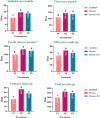Boron bioavailability enhanced by foliar applied fulvic acid to improve grain yield and quality of fine basmati rice
- PMID: 40846871
- PMCID: PMC12373719
- DOI: 10.1038/s41598-025-04747-1
Boron bioavailability enhanced by foliar applied fulvic acid to improve grain yield and quality of fine basmati rice
Abstract
Boron is a critical yet poorly understood micronutrient, especially regarding its transport within plant leaves. Little research has been done to enhance the bioavailability of Boron in rice using organic compounds like fulvic acid for better nutrient quality and yield. While fulvic acid (FA) is well-known for enhancing the mobility of metallic nutrients like iron (Fe) and zinc (Zn), however, its role in facilitating Boron, a metalloid, remains unclear. Therefore, this study aimed to evaluate the potential of FA in mediating Boron transport to improve grain quality and yield in Basmati rice. A field trial was conducted using a randomized complete block design (13 × 24 ft²), applying foliar treatments of Boron alone and Boron combined with FA at critical growth stages (tillering and panicle formation). The study assessed the impact of these treatments on rice morpho-physiological parameters, grain yield and leaf Boron content. The results revealed that both foliar treatments significantly improved yield and leaf Boron content over control. However, the promising results were obtained in response to boron's only application. Boron application (T2) significantly increased number of tillers (41%), chlorophyll content (55%), 1000 grain weight (32%), Boron content (131%) and yield per plot (43) as compared to control (T1). While combined application Boron + FA (T3) substantially enhanced number of tillers (34%), fertile florets per panicle (23%), Boron content (46%) and yield per plot (33%) over control (T1). The present findings suggest that Boron foliar application enhances grain weight, yield, and rice quality while reducing panicle sterility. However, FA did not significantly mediate Boron uptake in rice, indicating limited interaction between FA and this non-metallic micronutrient.
Keywords: Fertile florets per panicle; Fulvic acid; Leaf Boron content; Panicle sterility; Tillering.
© 2025. The Author(s).
Conflict of interest statement
Declarations. Competing interests: The authors declare no competing interests.
Figures




Similar articles
-
Evaluation of Blast Resistance in Zinc-Biofortified Rice.Plants (Basel). 2025 Jul 1;14(13):2016. doi: 10.3390/plants14132016. Plants (Basel). 2025. PMID: 40648025 Free PMC article.
-
Regulation of foliar salicylic acid at the heading stage enhances the grain 2-acetyl-1-pyrroline content and yield in fragrant rice.PLoS One. 2025 Jul 2;20(7):e0326578. doi: 10.1371/journal.pone.0326578. eCollection 2025. PLoS One. 2025. PMID: 40601784 Free PMC article.
-
Impact of foliar application using amino acids, yeast extract, and algae extract in different concentrations on growth parameters, yield traits, grain quality, and nitrogen-related parameters of wheat in arid environments.PeerJ. 2025 Aug 15;13:e19802. doi: 10.7717/peerj.19802. eCollection 2025. PeerJ. 2025. PMID: 40832582 Free PMC article.
-
The Black Book of Psychotropic Dosing and Monitoring.Psychopharmacol Bull. 2024 Jul 8;54(3):8-59. Psychopharmacol Bull. 2024. PMID: 38993656 Free PMC article. Review.
-
Systemic pharmacological treatments for chronic plaque psoriasis: a network meta-analysis.Cochrane Database Syst Rev. 2017 Dec 22;12(12):CD011535. doi: 10.1002/14651858.CD011535.pub2. Cochrane Database Syst Rev. 2017. Update in: Cochrane Database Syst Rev. 2020 Jan 9;1:CD011535. doi: 10.1002/14651858.CD011535.pub3. PMID: 29271481 Free PMC article. Updated.
References
-
- Gnanamanickam, S. S. Rice and Its Importance to Human Life. in Biological Control of Rice Diseases 1–11Springer Netherlands, Dordrecht, (2009).
-
- Mohapatra, P. K. & Sahu, B. B. Importance of rice as human food. in Panicle Architecture of Rice and its Relationship with Grain Filling 1–25 (Springer International Publishing, Cham, (2022).
-
- Zhao, M., Lin, Y. & Chen, H. Improving nutritional quality of rice for human health. Theor. Appl. Genet.133, 1397–1413 (2020). - PubMed
-
- Fahad, S. et al. Major constraints for global rice production. in Advances in Rice Research for Abiotic Stress Tolerance 1–22 (Elsevier, (2019).
-
- Gadal, N., Shrestha, J., Poudel, M. N. & Pokharel, B. A review on production status and growing environments of rice in Nepal and in the world. Archives Agric. Environ. Sci.4, 83–87 (2019).
MeSH terms
Substances
Grants and funding
LinkOut - more resources
Full Text Sources

